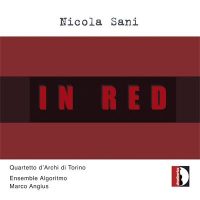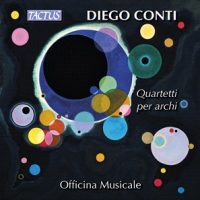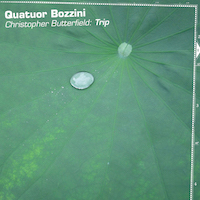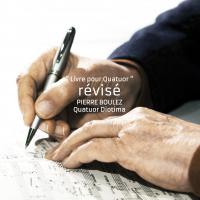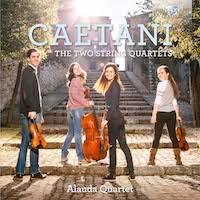String Theory 25: 12 Quartets, etc.
|
Grant Chu Covell [January 2018.]
“In Red.” Nicola SANI: Four Darks in Red (2010)a; Studio per le ali (2004); Black Area in Reds (2011)b. Quartetto d’Archi di Torino a,b: Gianluca Turconi, Umberto Fantini (vln), Andrea Repetto (vla), Manuel Zigante (vlc), Ensemble Algoritmob: Roberta Gottardi (clar), Ciro Longobardi (pno), Antonio Caggiano (perc), Fabio Ferria,b (sound eng.), Nicola Sani a,b (sound dir.), Marcus Angiusb (cond.). Stradivarius STR 33919 (1 CD) (http://www.stradivarius.it/). Mark Rothko’s late-period canvasses can be uncomfortable viewing. Some merely see big panels of color, others see obsessive depths and the pained results of a complicated artist. Despite the simple or almost non-existent forms, darkly hued rectangular shapes float in space, inviting contemplation which may lead towards anxiety or claustrophobia. Rothko’s Four Darks in Red is large (102 x 116 inches) with rectangles of black and brown hovering over blood red. Rothko worked by superimposing layers of paint and other materials, so that the dense hues appear to float or vibrate over an intense background. Sani has set himself the task of responding to Rothko’s work. Clearly it’s not possible to replicate the canvasses’ images with music, but it is possible to present forms and shapes that reflect Rothko’s expansive vision and bold color fields. Sani’s Four Darks in Red is for string quartet and a tape derived from stringed instrument sounds. The live quartet drifts across its distorted twin. This fascinating soundscape alternates between coarse and effervescent. I hear the particular sound achieved when strings are massively overdubbed which recalls the same effect prominent in the tape part of Nono’s La lontananza nostalgica utopica futura. Black Area in Reds pushes the process forward, adding clarinet, piano and percussion to the string quartet. Unlike Four Darks, which was awash in string sounds, the non-homogenous timbres of Black Area build counterbalancing layers. Electronics gently distort multiphonic clarinet and percussive piano. The percussion ties it all together. It is an altogether different response to Rothko. If Four Darks rubbed our faces in the canvas as if to overwhelm, Black Area steps back to take it all in, including the viewing space, perhaps also pulsing ceiling lights and the clicking heels of viewers strolling around. Black Area is less stifling than Four Darks, but still petulant. Sandwiched between the Rothko considerations, Studio per le ali, for tape alone, steps back several years. Events move slowly and at a grand scale that spreads elastically across a full spectrum that can be described as metallic or elemental. I hear qualities which I have learned to associate with Sani’s work, the processed sound of sand and water striking different surfaces, neatly disguised to create something familiar and universal, intriguing and edgy. The abstruse notes introduce us to the Austrian physicist Ludwig Boltzmann’s entropy formula, S = k log W. We are meant to understand that in these pieces Sani is exploring entropy and disorder by setting up schemes that contain their own unpredictability. Perhaps this is easiest to hear in Studio per le ali where slower, calmer material degrades into faster, chaotic material. The transformations may be hard to spy because of the absorbing sounds, but a listener may speculate on what might set these noises in motion.
“Quartetti per Archi.” Diego CONTI: Quartetto No. 1 (2007); Quartetto No. 2 (2007); Quartetto No. 3 (2008); Quartetto No. 4 (2009); Quartetto No. 5 (2010); Quartetto No. 6 (2012). Officina Musicale: Daniela Cammarano, Daniele Orlando (vln), Zita Pintér (vla), Antonio Mostacci (vlc). Tactus TC 950390 (2 CD) (http://www.tactus.it/). Conti has produced an impressive series of quartets in just a few years. An experienced violinist, Conti confidently negotiates a never-boring catalog of devices and textures. Now and again the music will settle into a groove and loop a gesture, but that doesn’t qualify the work as minimal or repetitive. Considering structure, it seems that once completed, pages were set aside without a second thought. This does lend the music a continually refreshing fluidity as material appears and departs. In the multi-movement quartets (Nos. 1, 2, 3 and 5), the movement breaks feel arbitrary, and congruently, audible divisions and changes of mood appear in the single-spanned Nos. 4 and 6. In terms of style, beyond the surreptitious glances at minimalism, the dissonant language rarely strays from Bartók. Conti’s ensemble balance (unisons, underscoring chords and melodies with selective pizzicato) often recall the Hungarian exemplar, as if these are fanciful departures from No. 6’s Mestos. Conti’s openness to varied influences may suggest Schnittke, but there is none of the sarcasm or glacial dread. The central movement of No. 1 is called Ninna nanna and it’s possible to hear a lullaby. The potpourri Scherzo of No. 5 flirts with many things including Piazzolla. The florid notes propose that Conti’s oeuvre is concerned with memory, and that his gestures intend to conjure other eras and genres. When we consider these are Italian quartets, they fall closer to Nono and Scelsi’s modernist realism rather than Puccini’s Romanticism. Even so, Conti shuns formalism and instead vigorously explores moods and styles. Cammarano and Orlando alternate first and second violin parts. Presented chronologically in two groups of three, the discs are 45:10 and 63:32. I would gladly hear more.
“Trip.” Christopher BUTTERFIELD: Lullaby (1991)1; beach whistle (1993)2; Clinamen (1999)3; fall (2013)4; Trip (2008)5. Jennifer Thiessen1 (vla), Elinor Frey1 (vlc); Quatuor Bozzini: Clemens Merkel1,3,4,5, Alissa Cheung1,4,5 (vln), Stéphanie Bozzini1,4,5 (vla), Isabelle Bozzini1,2,4,5 (vlc). Collection QB CQB 1719 (1 CD) (http://www.quatuorbozzini.ca/). Butterfield’s pieces suggest an unschooled or outsider’s approach. In actuality, we hear an unsettling union of chance and specificity. Titled deceptively, the string sextet Lullaby starts quietly, almost atmospherically, and suddenly stumbles upon a descending sequence which elsewhere might serve a harmonic function but here seems to be purely decorative. Clinamen requires that the solo violinist navigate at will across 80 short phrases printed on cards. The brief gestures, some immediately repeated, make for nearly 15 minutes of ambiguous restlessness. Evidently Butterfield rails against form and traditional logic. Written for the Quatuor Bozzini, fall repeats chords derived from a four-note cell, except the players have randomly chosen dynamics which disturb the voice leading and create an illusion of harmony and motion. Trip, also written for the Bozzini, serializes pitches but applies durations using chance. Dynamics and structure were finalized later. A radio broadcast emerges in the first movement, and the final movement dwarfs the preceding three. If the first three were perky bagatelles, the finale is slow and disconsolate. The Bozzini deliver with aplomb, and yet it’s hard to know what to make of it all. In Japan there is a tradition of women pearl divers (ama). The sound they make as they return to the surface to breathe is called isobue or beach whistle, in a loose translation. The solo cello alternates slowly between high and low (like the divers), held tones, and rasping pizzicato. Most of the other pieces give off motion and end unexpectedly, but stay rooted to the same place. Beach whistle is uniquely descriptive among this curious collection.
Pierre BOULEZ: Livre pour Quatuor (1948-49, ’54; rev. 2012). Quatuor Diotima: Yun Peng Zhao, Guillaume Latour (vln), Franck Chevalier (vla), Pierre Morlet (vlc). Megadisc MDC 7796 (1 CD) (http://www.megadisc-classics.com/). Boulez was 23 when he started his string quartet. Despite revisions it remains incomplete although this final partitioning achieved with the willing Quatuor Diotima makes it much less enigmatic. Work on the quartet began just after Piano Sonata No. 2 (1948) and includes some of its material. Livre appears in the Boulez-Cage correspondence: The piece could have evolved without barlines or meter, but even after time signatures and playing indications were added, the rare performances revealed impracticalities. Decades later, a more experienced Boulez elaborated upon two movements to create Livre pour Cordes (1968; rev. 1988), but the original’s fourth movement was never finished. Quatuor Diotima labored intensively with the composer to create this version and recording, including clarifying complex events and refining tempi. The group’s notes reflect a young ensemble working with an older master who in turn is generously revisiting an apprentice work. It is possible to hear Boulez becoming Boulez as arid precision (think of Structures) transforms into dissonant voluptuousness. There are five movements (I, II, III, V and VI), some with distinct parts (I has two, III has three). Rhythmic structures, including inaudible canons, take precedence over harmony. III is unexpectedly lyrical; trills contribute a Baroque flavor. It may be the illusion of gradual familiarity, but as the music progresses note values seem to lengthen, as one might relax while settling into an unfamiliar chair. The Diotima tackles this serial dartboard with great warmth and perception; it is as if Boulez is looking back to say he wasn’t such a rebel after all.
Roffredo CAETANI: Quartetto No. 1, Op. 1 (1888); Quartetto No. 2, Op. 12 (1907). Alauda Quartet: Cristina Prats-Costa, Milan Berginc (vln), Rhoslyn Lawton (vla), Elena Cappelletti (vlc). Brilliant Classics 95198 (1 CD) (http://www.brilliantclassics.com/). Caetani’s musical endeavors were encouraged by none other than Liszt, perhaps the best possible 19th-century musical godfather. However, Caetani is no Wagner. The First quartet betrays occasional awkwardness in its opening chords and elsewhere, when the accompaniment’s patterns could be copied from a pianist’s left hand. This single movement strives for a Mendelssohnian lightness across its multiple sections. Caetani (1871-1961) was 17 when it was first performed. Quartet No. 2 followed nearly 20 years later and is a mature work. Harmonic twists reveal an inclination towards folk tunes and the exotic. The assertive harmonies and tuneful lines are late Romantic, but not as extreme as Strauss or Schoenberg. The notes indicate a preference towards an Hungarian scale even through the final Presto suggests a tarantella. Based in London, the Alauda Quartet is a young ensemble and well up to the challenge of presenting these first recordings.
[Previous Article:
String Theory 24: Quartets in Different Intonation (at least 15 of them)]
[Next Article:
A Catalogue of Darknesses, Part 1.]
|
